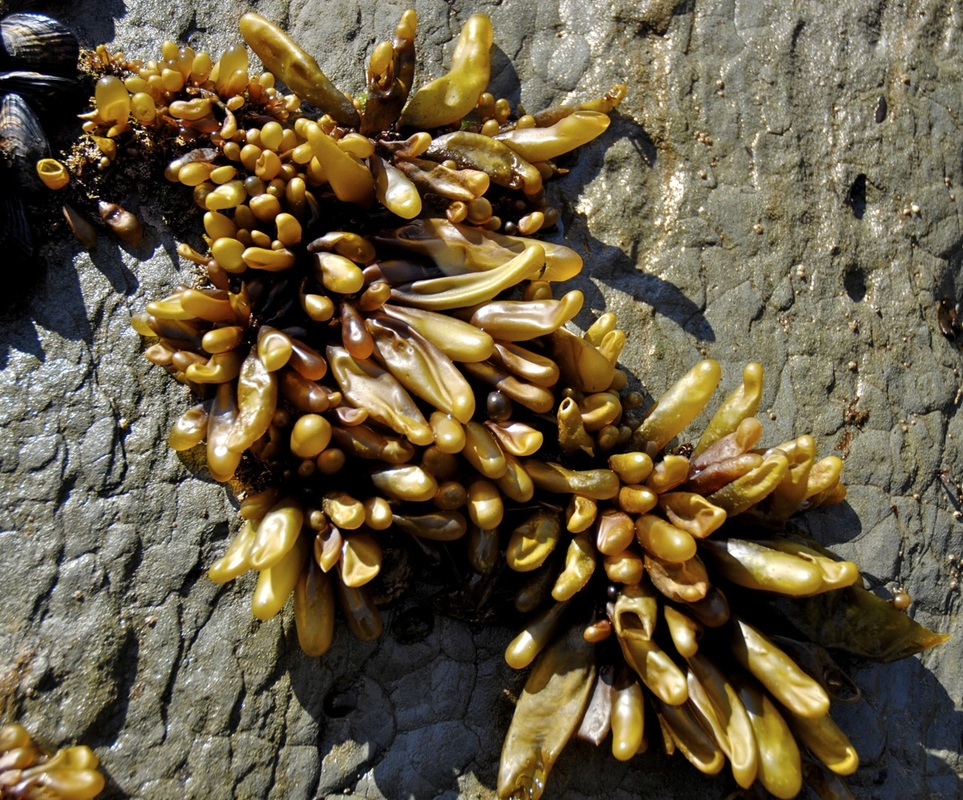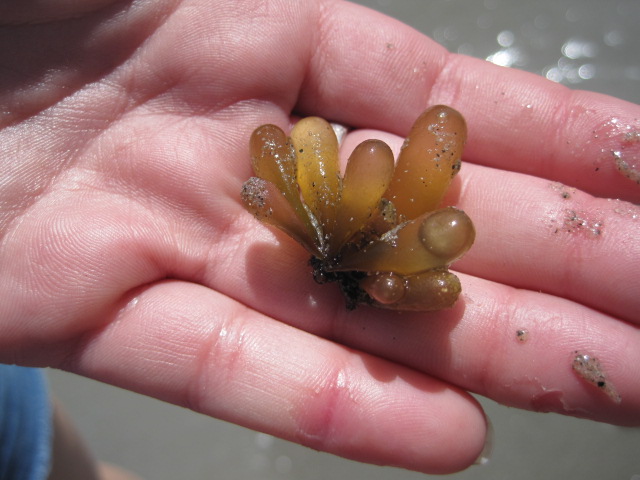Sea sacs, salt sacs, dead man's fingers • Halosaccion glandiforme, Halosaccion americanum
Identification
Resembling clusters of inflated rubber glove fingers, the name 'dead man's fingers' is highly descriptive of this red seaweed's shape. Sometimes the "fingers" will be deflated, but usually they are filled with water. This species varies in colour from purple-red to yellowy-green or brownish. While it can reach 30 cm tall, it is more commonly found at half that size or less. The 'fingers' attach to rocks via small disc-shaped holdfasts.
Habitat & Range
This species usually grows in clusters on rock in the mid- to low intertidal, on exposed and semi-exposed shorelines. Its range extends from the Aleutian Islands to California.
Intriguing Info
In Marine Life of the Pacific Northwest, Lamb and Hanby point out that these water-filled sacs can be quite successfully used as water pistols. When squeezed, the water inflating the sac escapes from tiny pores. The long and narrow water-filled sacs protect the species from the high-energy waves it encounters in its habitat, as well as from desiccation during low tides and on hot days.
Sea sacs are commonly eaten by limpets and black turban snails, and the interiors of the sacs are used as shelter by creatures such as amphipods and microscopic nematodes.
iNaturalist
https://www.inaturalist.org/taxa/123649-Halosaccion-glandiforme
Resembling clusters of inflated rubber glove fingers, the name 'dead man's fingers' is highly descriptive of this red seaweed's shape. Sometimes the "fingers" will be deflated, but usually they are filled with water. This species varies in colour from purple-red to yellowy-green or brownish. While it can reach 30 cm tall, it is more commonly found at half that size or less. The 'fingers' attach to rocks via small disc-shaped holdfasts.
Habitat & Range
This species usually grows in clusters on rock in the mid- to low intertidal, on exposed and semi-exposed shorelines. Its range extends from the Aleutian Islands to California.
Intriguing Info
In Marine Life of the Pacific Northwest, Lamb and Hanby point out that these water-filled sacs can be quite successfully used as water pistols. When squeezed, the water inflating the sac escapes from tiny pores. The long and narrow water-filled sacs protect the species from the high-energy waves it encounters in its habitat, as well as from desiccation during low tides and on hot days.
Sea sacs are commonly eaten by limpets and black turban snails, and the interiors of the sacs are used as shelter by creatures such as amphipods and microscopic nematodes.
iNaturalist
https://www.inaturalist.org/taxa/123649-Halosaccion-glandiforme
References
Fletcher, A. (2001). Halosaccion glandiforme. The Race Rocks Taxonomy. Lester B. Pearson College. Accessed 24/06/2013
Harbo, R. M. (1999). Whelks to whales: Coastal marine life of the Pacific Northwest. Madeira Park, BC: Harbour Publishing. P. 208.
Lamb, A., and Hanby, B. (2005). Marine Life of the Pacific Northwest. Madeira Park, BC: Harbour Publishing. P. 41
Mosquin, D. (2006). Halosaccion glandiforme. Botany Photo of the Day. UBC Botanical Garden and Centre for Plant Research. Accessed 24/06/2013
Authors and editors of page
Kelly Fretwell and Brian Starzomski (2013).
Fletcher, A. (2001). Halosaccion glandiforme. The Race Rocks Taxonomy. Lester B. Pearson College. Accessed 24/06/2013
Harbo, R. M. (1999). Whelks to whales: Coastal marine life of the Pacific Northwest. Madeira Park, BC: Harbour Publishing. P. 208.
Lamb, A., and Hanby, B. (2005). Marine Life of the Pacific Northwest. Madeira Park, BC: Harbour Publishing. P. 41
Mosquin, D. (2006). Halosaccion glandiforme. Botany Photo of the Day. UBC Botanical Garden and Centre for Plant Research. Accessed 24/06/2013
Authors and editors of page
Kelly Fretwell and Brian Starzomski (2013).







